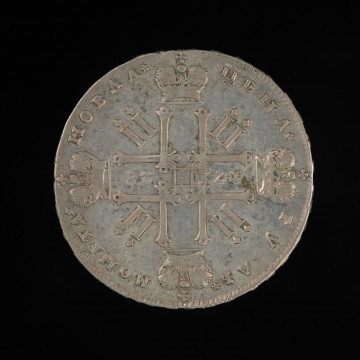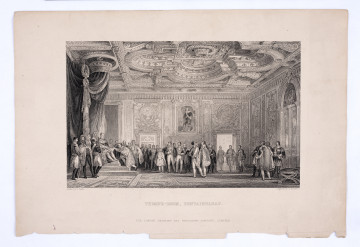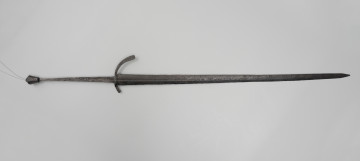
Ruble
1728
National Museum in Szczecin
Part of the collection: European and non-European coins
The introduction of the thaler in the German Reich prompted the Danish rulers to carry out a similar reform in the early 16th century. Denmark had no silver deposits to allow efficient minting. The scarcity of raw material combined with the Scandinavian minting tradition meant that reforms, which in most European countries went fairly smoothly, were a major problem in Denmark. In 1625, during another minting reform, a kroner (crown) worth 4 Danish marks was introduced – it was similar to the coin displayed above. This striking, yet modest coin was minted in Copenhagen by King Frederick III of Denmark (1609-1670). The royal monogram on the obverse of the coin is surrounded by an inscription with its value - IIII MARCK DANSKE – a key information for the user. The reverse of the crown refers to the Scandinavian traditional motif of a coat of arms on an isosceles cross, common to coins. Northern Europe resisted Christianisation for a long time, and was always perceived as a haven for paganism. Placing a cross on coins highlighted the fact that the country belonged to the community of Christian states. One of the interesting elements of the coin is the Latin inscription The Lord will provide on the reverse – a paraphrase of Abraham's words to Isaac (Genesis 22:8). This is a remarkable declaration, especially in the context of the monetary chaos in Denmark, suggesting that by God's providence there would be no shortage of silver for Danish coins. The numerous monetary reforms carried out by Danish rulers were seen as a disruption by the general public – this is due to the fact that the reforms focused on introducing new coins and name changes, rather than increasing the real value of money. From the end of the 17th century the subjects of the Danish kings also had to deal with a new problem - the inflation of paper money, which the Danish kings had used in an attempt to save the state finances.
Mieszko Pawłowski
Other names
Corona danica
Author / creator
Dimensions
cały obiekt: diameter: 42.1 mm
Object type
coin
Technique
minting
Material
silver
Creation time / dating
Creation / finding place
Owner
National Museum in Szczecin
Identification number
Location / status

1728
National Museum in Szczecin

1840 — 1850
National Museum in Szczecin

circa 1390 — 1450
National Museum in Szczecin
DISCOVER this TOPIC
National Museum in Szczecin
DISCOVER this PATH
Educational path